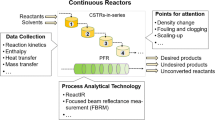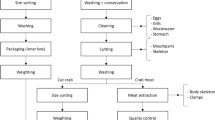Abstract
Batch sterilization with individual retorts is a common mode of operation in many food-canning plants. Although high-speed processing with continuous rotary or hydrostatic retort systems is used in very large canning factories, such systems are not economically feasible in the majority of small- to medium-sized canneries. In such canneries, sterilization is carried out in a battery of retorts as a batch process. Although the unloading and reloading operations for each retort are labor intensive, a well-designed and managed plant can operate with surprising efficiency if it has the optimum number of retorts and scheduling of retort operation. The objective of this research was to present two mathematical models for sterilization scheduling in food-canning plants. The first model developed is for the case where given amount of different canned food products with specific quality requirements would be sterilized within a minimum plant operation time in an autoclave of given capacity. The second model addresses the problem of maximizing the amount of sterilized products in an autoclave of given capacity for given plant operation time. The developed models were based on mixed-integer linear programming and incorporated the possibility of simultaneous sterilization. Simultaneous sterilization applies mainly to small canneries with few retorts. In these situations, retorts often operate with only partial loads because of the small lot sizes, and they are severely under-utilized. In order to demonstrate the feasibility of the mixed-integer linear programming (MILP) models, several examples involving the sterilization of different products were included in this research. The methodology proposed in this study is of special relevance for small- and medium-sized food-canning plants that normally work with many different products at the same time.


Similar content being viewed by others
References
Barbosa, A. P.,& Macchietto, S. (1993). Optimal design of multipurpose batch plants 1. Problem Formulation, Computers and Chemical Engineering, 17, S33–S38.
Castro, P. M.,& Grossmann, I. E. (2006). An efficient MILP model for the short-term scheduling of single stage batch plants. Computers and Chemical Engineering, 30, 1003–1018.
Castro, P. M.,& Grossmann, I. E. (2005). New continuous-time MILP model for the short-term scheduling of multi-stage batch plants. Industrial Engineering Chemistry Research, 44(24), 9175– 9190.
Doganisa, P.,& Sarimveis, H. (2007). Optimal scheduling in a yogurt production line based on mixed integer linear programming. Journal of Food Engineering, 80, 445–453.
Doganis, P.,& Sarimveis, H. (2009). Mixed integer linear programmin scheduling in the food industry. In F. Erdogdu (Ed.), Optimization in food engineering (p. 800). Boca Raton: CRC Press.
Erdirik-Dogan, M.,& Grossmann, I. (2007). Simultaneous planning and scheduling of single-stage multi-product continuous plants with parallel lines. Computers and Chemical Engineering, 32(11), 2626–2642.
Floudas, C. A.,& Lin, X. (2004). Continuous-time versus discrete-time approaches for scheduling of chemical processes: A review. Computers and Chemical Engineering, 28(11), 2109–2129.
Gupta, S.,& Karimi, I. A. (2003). Animproved MILP formulation for scheduling multi-product, multi-stage batch plants. Industrial and Engineering Chemistry Research, 42(11), 2365–2380.
Ha, J. H., Chang, H. K., Lee, E. S., Lee, I. B., Lee, B. S.,& Yi, G. (2006). Inter-stage storage tank operation strategies in the production scheduling of multi-product batch processes. Computers and Chemical Engineering, 24, 1633–1640.
Harjunkoski, I.,& Grossmann, I. E. (2002). Decomposition techniques for multistage scheduling problems using mixed-integer and constraint programming methods. Computers and Chemical Engineering, 26, 1533.
Holdsworth, S. D. (1997). Thermal processing of packaged foods. London: Blackie Academic& Professional.
Holdsworth, S. D.& Simpson, R. (2007). Thermal processing of packaged foods (2nd ed.). New York: Springer.
Hui, C.-W.,& Natori, Y. (1996). An industrial application using mixed-integer programming technique: A multi-period utility system model. Computers and Chemical Engineering, S20, S1577–S1582.
Jung, J. H., Lee, H. K.,& Lee, I. B. (1994). Completion times and optimal scheduling for serial multi-product processes with transfer and set-up times in zero-wait policy. Computers and Chemical Engineering, 18, 537–544.
Kondili, C., Pantelides, R.,& Sargent, H. (1993). A general algorithm for short-term scheduling of batch operations-I. MILP Formulation, Computers and Chemical Engineering, 17, 211–227.
Lee, B.,& Reklaitis, G. V. (1995a). Optimal scheduling of cyclic batch processes for heat integration-I. Basic Formulation, Computers and Chemical Engineering, 19(8), 883–905.
Lee, B.,& Reklaitis, G. V. (1995b). Optimal scheduling of cyclic batch processes for heat integration-II. Extended Problems, Computers and Chemical Engineering, 19(8), 907–931.
Liu, Y.,& Karimi, I. (2008). Scheduling multistage batch plants with parallel units and no interstage storage. Computers and Chemical Engineering, 32, 671–693.
Maravelias, C. T. (2006). A decomposition framework for the scheduling of single- and multi-stage processes. Computers and Chemical Engineering, 30, 407–420.
Méndez, C.,& Cerda, J. (2000). Optimal scheduling of a resource-constrained multiproduct batch plant supplying intermediates to nearby end-product facilities. Computers and Chemical Engineering, 24, 369.
Méndez, C.,& Cerda, J. (2002). An efficient MILP continuous-time formulation for short-term scheduling of multiproduct continuous facilities. Computers and Chemical Engineering, 26, 687.
Mendez, C. A., Henning, G. P.,& Cerda, J. (2001). An MILP continuous time approach to short-term scheduling of resource-constrained multi-stage flowshop batch facilities. Computers and Chemical Engineering, 25, 701–711.
Mendez, C. A., Cerda, J., Grossmann, I. E., Harjunkoski, I.,& Fahl, M. (2006). State-of-the-art review of optimization methods for short-term scheduling of batch processes. Computers and Chemical Engineering, 30(6–7), 913–946.
Moon, S., Park, S.,& Lee, W. K. (1996). New MILP models for scheduling of multi-product batch plants under Zero-Wait policy. Industrial and Engineering Chemistry Research, 35, 3458–3469.
Norback, J.,& Rattunde, M. (1991). Production planning when batching is part of the manufacturing sequence. Journal of Food Processing Engineering, 14, 107–123.
Reklaitis, G. V. (1996). Overview of scheduling and planning of batch process operations. In G. V. Reklaitis, A. K. Sunol, D. W. Rippin,& O. Hortacsu (Eds.), Batch processing system engineering (pp. 660–705). Berlin: Springer.
Rippin, D. W. (1993). Batch process system engineering: A retrospective and prospective review. Computer and Chemical engineering, 17, S1–S13.
Simpson, R., Almonacid, S.,& Teixeira, A. (2003a). Optimization criteria for batch retort battery design and operation in food canning-plants. Journal of Food Processing Engineering, 25(6), 515–538.
Simpson, R., Almonacid, S.,& Teixeira, A. (2003b). Bigelow’s general method revisited: Development of a new calculation technique. Journal of Food Science, 68(4), 1324–1333.
Simpson, R. (2005). Generation of isolethal processes and implementation of simultaneous sterilization utilizing the revisited general method. Journal of Food Engineering, 67(1–2), 71–79.
Simpson, R.,& Abakarov, A. (2009). Optimal scheduling of canned food plants including simultaneous sterilization. Journal of Food Engineering, 90(2009), 53–59.
Acknowledgments
The authors are grateful for the financial support provided by CONICYT through the FONDECYT project number 1090628.
Author information
Authors and Affiliations
Corresponding author
Rights and permissions
About this article
Cite this article
Simpson, R., Abakarov, A. Mixed-integer linear programming models for batch sterilization of packaged-foods plants. J Sched 16, 59–68 (2013). https://doi.org/10.1007/s10951-012-0298-5
Published:
Issue Date:
DOI: https://doi.org/10.1007/s10951-012-0298-5




